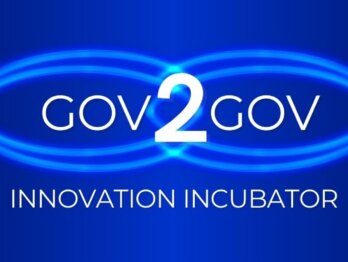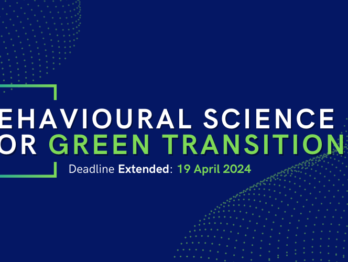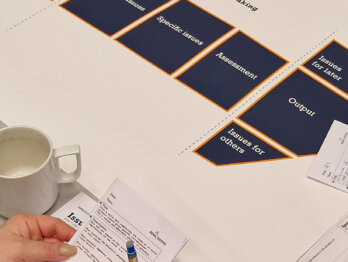Using innovation methods to enhance and improve core government policy-making and services

On May 11th 2021, OPSI hosted a workshop in partnership with the Austrian Federal Ministry for Civil Service and Sport on Enhancement-Oriented Innovation, as part of our ongoing work on the Innovation facets through our Horizon 2020 programme of research. Over 100 people representing 36 nationalities joined us to hear about the relationships between innovation and public sector efficiency and productivity, as well as methods and tools for Enhancement-Oriented Innovation. We were lucky to be joined by a roster of international experts, who illuminated theoretical dimensions of this type of innovation, as well as shared successful examples of projects to serve as inspiration for our participants. A recording of the session can be found here.
Following introductory remarks from our host from Austria, Michael Kallinger, OPSI’s Piret Tõnurist first set the framing for the workshop by explaining what is meant by Enhancement-Oriented Innovation: innovations that seek to improve or upgrade practices, achieving better results or efficiencies, and usually building on existing structures and value paradigms. These innovations are often more incremental than transformative, but can serve as a gateway to riskier innovations and more structural changes. These are the backbone and majority of innovations in government, and normally comprise a large proportion of the innovation portfolios of government agencies.
Subsequently we received three sets of remarks from experts who offered different approaches to understanding the principles of Enhancement-Oriented Innovation. Firstly, Patrick Dunleavy of the London School of Economics and Political Sciences (LSE) discussed the potential of increasing public sector productivity. Prof. Dunleavy identified three key drivers of public sector productivity change: specialisation and professionalisation, increasing capital intensity (e.g., introducing robotic process automation in immigration agencies), and external technological changes (e.g., digitalisation). While these forces have the potential to induce productivity gains, whether they are realised depends on the ability and context of the society, the clients, and the agency concerned to take up the productivity gain. He also explained the difference between productivity and efficiency (see image below).
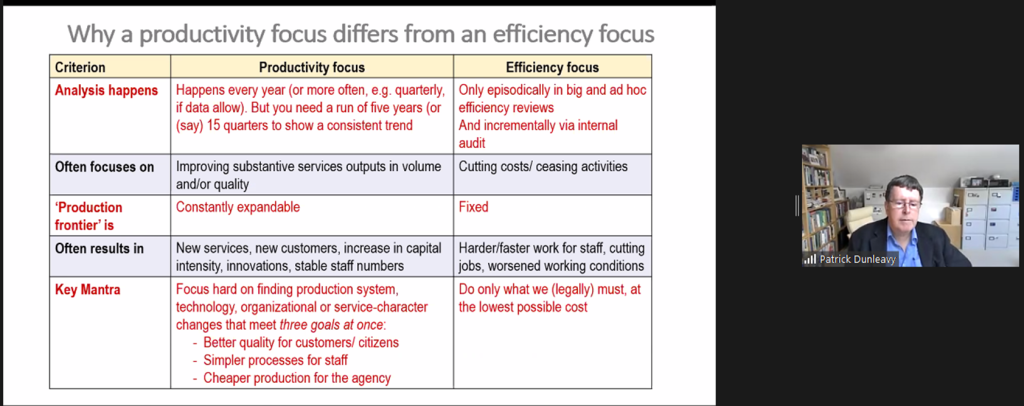
Then, Chiara Varazzini, lead of the OECD’s Behavioural Insights work, discussed why behavioural sciences can help public policy makers create more effective policies. Most public policies are dependent on implicit assumptions of human behaviour, as the COVID-19 pandemic has made particularly evident. However, most policy makers often assume an unrealistic model of human behaviour. Governments have three policy tools to change behaviours: information, regulation and incentives. These tools are often enough to change behaviour, which is why insights from behavioural science are both important and effective.
Finally, Dr. Tobias Polzer of the Vienna University of Economics and Business discussed the relationship between public administration paradigms and innovation. He shared his observation that some paradigms, like New Public Management, are aimed at increasing efficiency, whereas others such as new public governance focus on improving quality and enhancing innovation (see image below). The paradigmatic context matters for the success of any type of innovation. In the case of enhancement-oriented innovation, it most often takes the form of incremental innovation and small changes, but these can lead to transformational change over time.
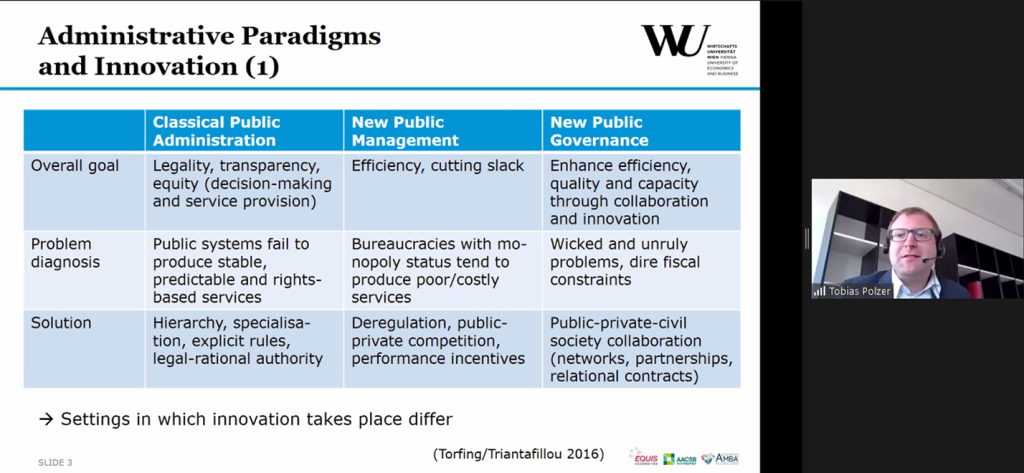
Case Study Presentations
First, Eva Sejrek-Tunke from the Vienna City administration described her first-hand impressions of Vienna’s citizen-oriented changes and innovations over time and the role of the Common Assessment Framework (CAF) in this. The CAF provides guidance for a modern public administration, especially on cultural change. The CAF includes in its foundations the ‘Principles of Excellence’ and the UN Sustainable Development Goals. It enables organisations to manage their organisational and cultural change to ensure total quality management that focuses on generating impacts under the values of sustainability and partnerships. An example of the application of CAF is the Smart City Vienna project, a process of continuous development that demonstrates the impact of the CAF in the Vienna Public Administration. It is the sustainability strategy of the city, built in the interest of citizens, maximising the quality of life through social and technological innovations, and grounded in sustainability and the SDGs at their core.
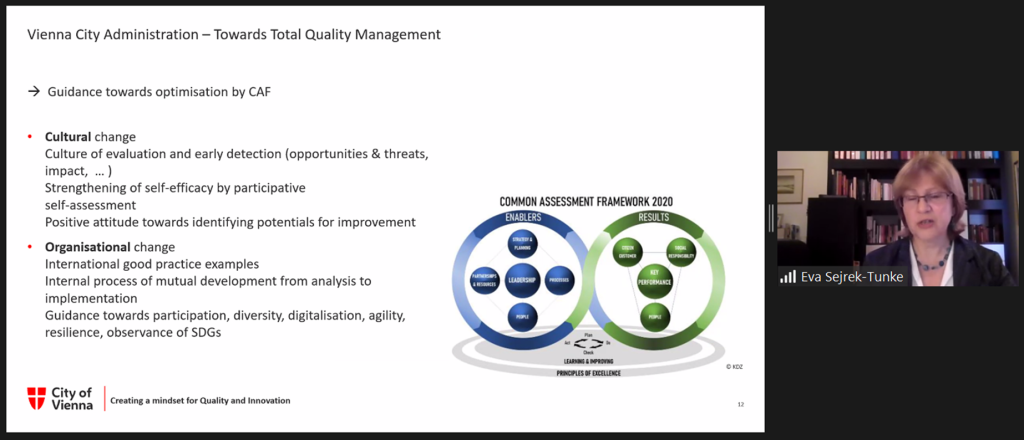
Then, Andrea Sturzlinger and Ernst Siller of the Austrian tax administration presented their work on digital tax administration and chatbot integration, focusing on the FinanzOnline platform. FinanzOnline can look back at a period of more than 20 years of incremental improvements and is the most used e-government portal in Austria. The customer service strategy of the tax administration is to present a single front-end for all target groups through the FinanzOnline platform. Most recently, through a new implementation approach that puts the user in the focus rather than working around legal changes: the team created applications for smartphones, the platform started supporting video chats, and was integrated in the broader IT landscape of the Austrian government.
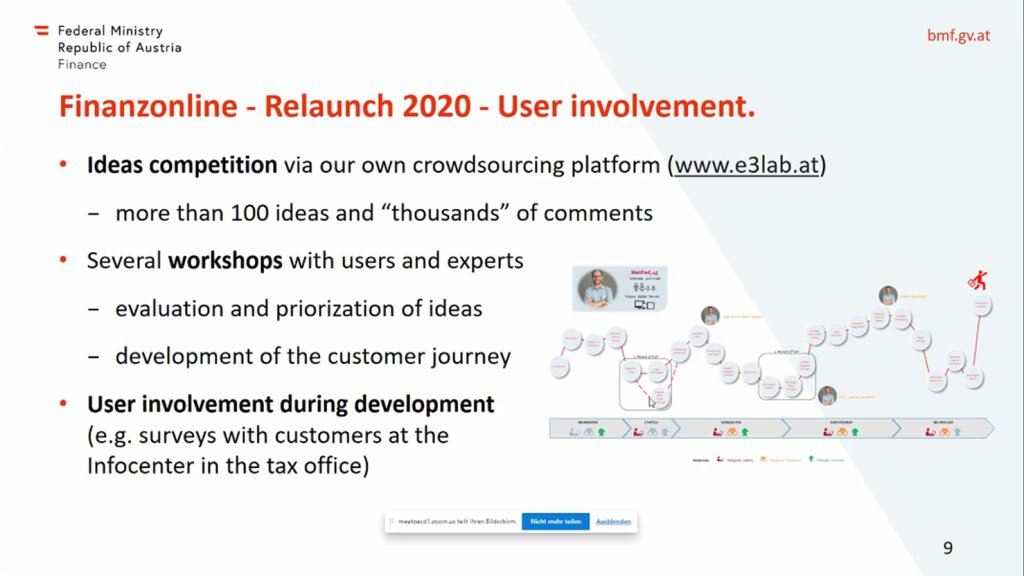
Breakout Discussions
Participants were then sorted into three breakout groups according to their interest in three different common approaches that use Enhancement-Oriented Innovation, placed alongside a case study of each type. One group focused on improving and redesigning services with Ana Couteiro of Portugal, looking at an innovative translation service for immigrants; another welcomed Scott Copley of Australia’s Behavioural Insights team (BETA) to discuss behavioural insights approaches to reduce antibiotics prescriptions; and a third group looked at technology and service delivery with Tiago Cravo Oliveira Hashiguchi, health policy expert from the OECD, on telemedicine.
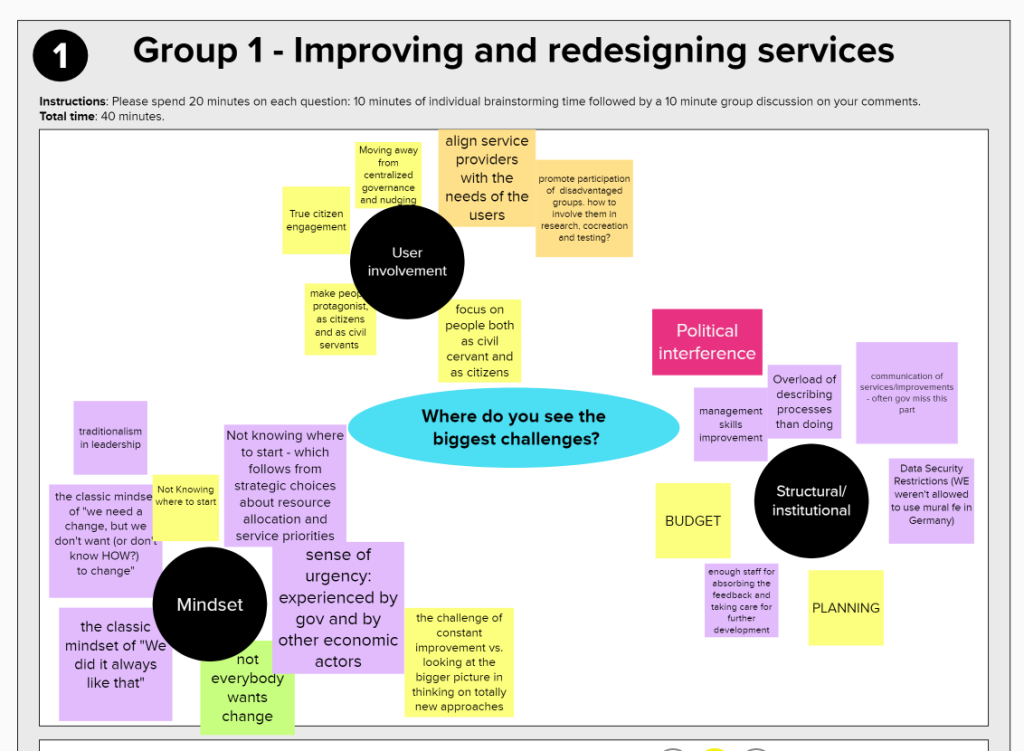
In the first group, Ana Couteiro from Portugal’s High Commission for Migration (ACM) discussed their Telephone Translation Service (STT). The service works with a database of 95 translators and interpreters to offer migrants immediate or scheduled translation in 68 different languages for free. The service is integrated across public agencies and provides citizens with information on various services, including social security, healthcare, police, and immigration and border services. Participants then discussed their own experiences, challenges (see image above), and the key tools used when trying to redesign and innovate existing services. The challenges identified included mindset issues, such as not knowing where to start when one wants to change a process or a service; structural problems, such as dealing with limited staff or budget to effectively bring about change; and user involvement issues, concerning mostly the difficulties faced when trying to involve citizens or civil servants to make sure that innovations match their demands and needs.
In the second breakout room, Scott Copley presented a randomised control trial experiment conducted by the Behavioural Economics Team of the Australian government (BETA) aimed at decreasing unnecessary antibiotics prescriptions. The trial was evaluated by comparing the change in doctors’ prescribing rates after they had received a letter about antibiotics over-prescription with those of a control group of doctors receiving no letter. The largest effects were observed for the group who received a peer-comparison illustrated by a graph, indicating that they were amongst the highest prescribers in their region. These “social norm” letters reduced prescriptions by 12.3%, four times higher than the letters including only educational content. Workshop participants discussed the challenges of scaling behavioural insights (BI) interventions (such as the one described in the case study), the issue of a lack of understanding around BI, as well as the lack of resources, instruments, data and expertise to even make use of the repertoire of tools that BI presents.
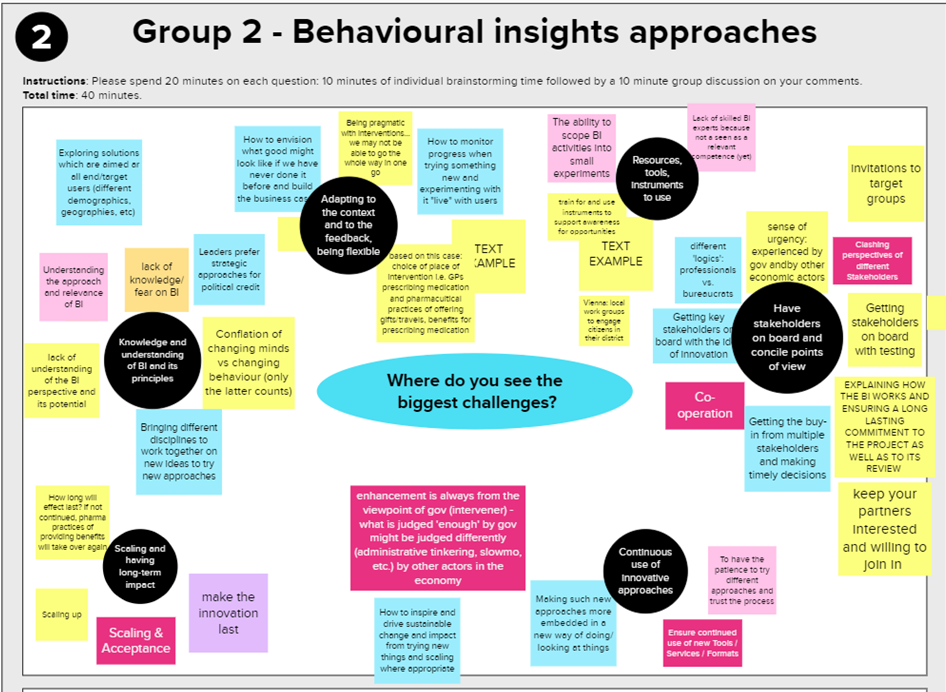
The last group started with Tiago Cravo Oliveira Hashiguchi from the OECD’s Directorate of Employment, Labour and Social Affairs presenting his team’s research on telemedicine. Mr. Hashiguchi highlighted how telemedicine entails significant uncertainties and the potential for inefficiencies and regional inequalities, but also how it holds strong promises of cost reductions, knowledge sharing, and patient empowerment. Experience from OECD countries shows that most barriers are not technological but institutional and cultural, and a supportive policy environment for telemedicine must address digital and geographical divides, scale-up through sustaining financing, and promote clarity through guidelines. Participants reflected on key methods emerging including the use of tools and platforms to increase inclusivity and user involvement; the use of design thinking; and, the establishment of experimentation spaces and of usability, accessibility and other proxies to evaluate new technologies.
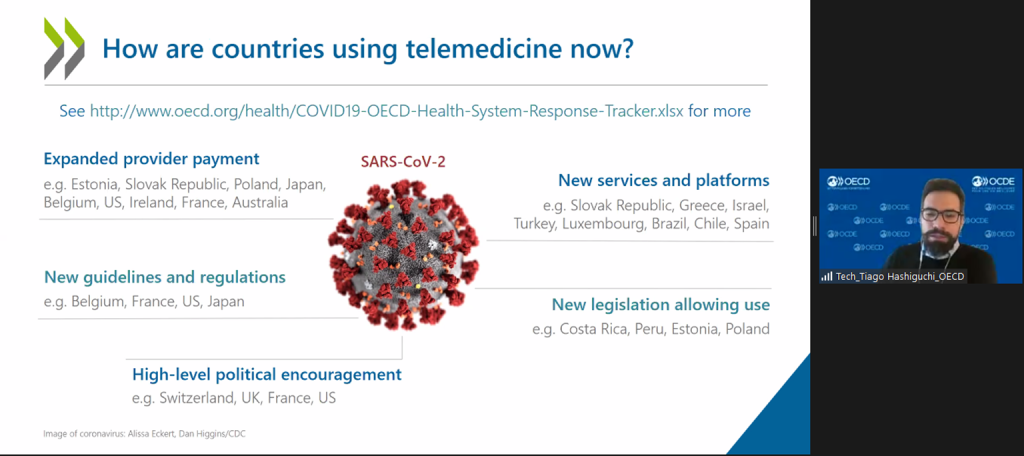
We were delighted with how the workshop went, and are extremely grateful for the Austrian Ministry of Civil Service and Sport for their help in partnering with us to deliver it. Not only did the workshop allow us to share insights, research and examples about the concept of Enhancement-Oriented Innovation as part of our effort to support countries to better understand their own innovation portfolios; but, it also will greatly inform our upcoming research. We are writing about Enhancement-Oriented Innovation as part of an Horizon 2020 report on our Innovation Facets.
This workshop particularly demonstrated the extraordinary impact of this type of innovation, whether that be in specific projects, in the productivity of the public sector as a whole, or in laying the foundations for more transformational change. However, it also revealed that our challenge, when writing the report, will be to tie all of these threads together to make the persuasive case for Enhancement-Oriented Innovation as a coherent concept. A brief on this topic should be published later in the year (around October), and the full report will be published by the end of the year. If you are interested in the topic, we recommend that you reach out to us at [email protected].





